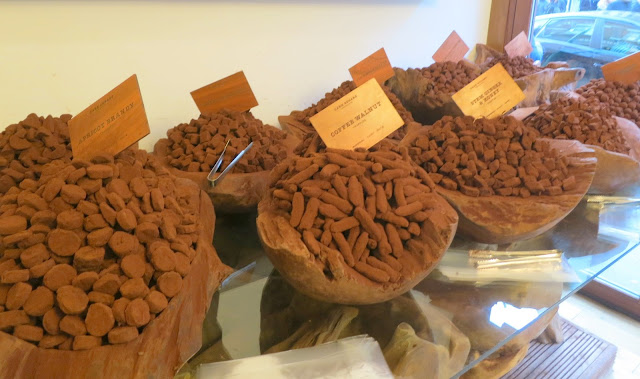During our recent visit to London we started with the Whitechapel Gallery, and then proceeded up Commercial Street to explore parts of Spitalfields.
Christ Church looked stunning in the sunshine, elegant and imposing. It was designed by Nicholas Hawksmoor and built between 1714 and 1729, in English baroque style. Built in an area that was dominated by Huguenot immigrants at the time, the aim of the build was to establish Anglican authority.
The church was closed so unfortunately, we were unable to go inside.
We then walked down Fournier Street admiring the Huguenot weaver's cottages. Escaping prosecution, a quarter of a million French speaking Calvinists came to this country in the 17th century and 25,000 settled in London. The silk weavers came to Spitalfields and brought French fashion with them. The increase in the availability of silk affected British upper class fashions as new styles became popular incorporating more of the readily available material.
The wealthier Huguenots built large houses both for their families and for the weavers they employed. The houses are extremely distinctive, with enlarged windows in the attic to let in maximum light for the weavers.

Because different builders were involved, all the houses look different. They are 5 stories high, with three windows across as this was the length of the timber used. A law was passed at the time decreeing that windows should be recessed by one brick, but this was ignored in Spitalfields.
Some of the houses are only one room deep.

Curtains were rarely used before the 19th century, so the houses had shutters.


By 1760 the area had lost its prosperity: competition from France and changes in fashion meant that master weavers could not pay journeymen anymore and family members had to undertake the work. Strikes and protests followed and journeymen started breaking into the cottages and smashing the machines. In 1773 the Spitalfields Act was introduced fixing wages and forbidding imports but this resulted in the sacking of more workers and the Act was repealed in 1824. The introduction of the Jacquard loom in the same year resulted in factories taking over the cottage industries and terrible poverty became the norm. Jewish immigrants started coming in, sweatshops were introduced and people lived in abject poverty so much so that panelling in the cottages was ripped up and used for firewood.

This was Jack the Ripper territory - 1 in 17 women was a prostitute.
I chuckled when we saw these two houses
Nos. Eleven and Eleven and A Half.
At the end of Fournier Street is the London Jamme Masjid (Great London Mosque). Originally, this was a Huguenot chapel, built in 1742. By 1809 it was used by missionaries as The Jews' Chapel, where Christianity was promoted to the expanding Jewish population. It was then adapted as a Methodist Chapel in 1819 for Protestant residents and in 1889 the building was consecrated as the Spitalfields Great Synagogue. In 1976, it was adapted again as a mosque to serve the expanding Bangladeshi community. All the changes of the area reflected in one building!
We then turned left into Brick Lane, a street that has a rich history. The first immigrants were the Huguenots, followed by the Irish and the Ashkenazi Jews. Jewish immigration continued into the early 20th century, followed by the Bangladeshis in the later 20th century who today are the predominant group in this part of the East End.
In the 1970s the National Front made their presence felt. The racist murder of Altab Ali in May 1978 led to a resistance movement beginning with the first ever Bengali march when some 10,000 Bengalis took to the street, supported by anti-racist organisations, trade unions and the anti-Nazi League. The resistance of these groups against the National Front are legendary and continued until the early 1980s.
More recently the area has broadened to being a vibrant art and fashion one, with considerable exhibition space. There were a lot of native and foreign tourists around when we visited, many more than three years ago when we were last there.
This gentrification of the area is best exemplified by this chocolate shop which has doubled in size since we were last there.
Their chocolates are exquisite:
We walked on up to the Truman brewery, which was established in 1683
stopped here for some delicious street food

and then turned right into the indoor market.
We then retraced our steps, through Fournier Street, and onto Commercial Street,
and entered Spitalfields Market, which is opposite Christ Church.
There has been a market on this site since 1638 when King Charles gave licence for flesh, fowl and roots to be sold on Spittle Fields, which was then a rural area on the eastern outskirts of London. After the rights to a market had seemingly lapsed during the time of the Commonwealth the market was re-founded in 1682 by King Charles II in order to feed the burgeoning population of a new suburb of London.
The original Victorian buildings and the market hall and roof have been restored and today Spitalfields is one of London's major markets.
Hats
clothes,
accessories,
table tennis outside one of the pubs,
Department of Coffee and Social Affairs, a witty name for a coffee shop.
It was impossible to walk through the food and beer sections of the market due to the crowds, but I did linger by this food stall where everything looked so stylish and delicious
By then we were overwhelmed by the crowds and left, having only seen a fraction of what was on display.
We walked past the All Saints store, the original, I presume,
wondered who the artist of this sculpture was,
caught a glimpse of the Gherkin







































No comments:
Post a Comment